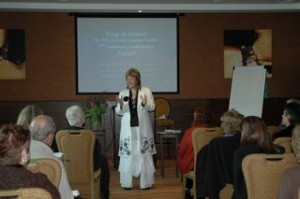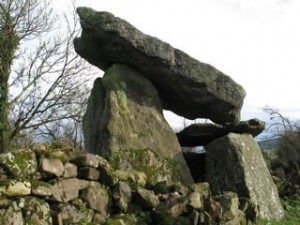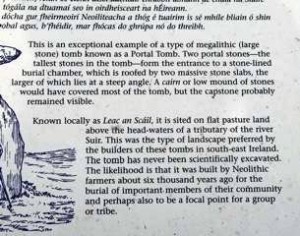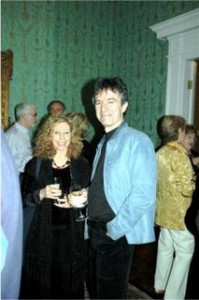
Guy Corneau standing with me at the farewell party. (I hate this picture of me but am trying to be less vain!)
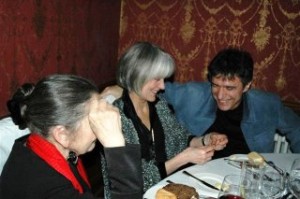
Presenters Jan Bauer and Guy Corneau (on the right) sitting with the oldest person who attended the conference (age 85 she proudly said). Youngest person was 18.
All photos courtesy of Dennis Eamon Young Photography 2007
“Harmony is singing any note your neighbor isn ‘t,” said Dr. Noirin Ni Riain , Irish vocalist and true Celtic spirit. Music, which is innate to the soul, was certainly intrinsic to this conference.
The first night as many of us gathered under the stars to witness the lunar eclipse, Noirin led us in spontaneous song, while Jungian analyst and author Guy Corneau guided us in reflection.
And the Universe took us through its magic. I actually saw the moon spin, but that’s another story for another time. Apparently, one of us was sending up spirals of energy that I somehow felt, but seemingly so did the moon.
Here is a small overview of what I learned: I saw therapy in a new light, and certainly a possibility for Jungian analysis I hadn ‘t previously recognized.
What came through strongly for me was the potential for therapy to go beyond our personal issues with our parents. (“We all had the wrong parents,” Guy Corneau declared and then exemplified how the standard birth process and the birth trauma itself are responsible for our existential angst.)
I heard the possibility for therapy to provide a kind of magnificent container in which an individual could incubate, grapple with and work toward living authentically. This is a process Jung calledindividuation.
Since this was a conference about issues we deal with at mid-life and beyond there was an assumption that we were no longer in the struggle of establishing the ego or our initial steps as adults.
We talked about masks. Wendy Doniger ‘s lecture, “The Woman Who Pretended to Be Who She Was,” captured the essence of this idea about being and becoming one’s self when in fact we are a multitude of selves.
Ms. Doniger differentiated our many selves from multiple or borderline personality disorder, for instance, by asserting that people with those disorders are all mask without a stable sense of self, and in fact are hollow inside.
As a side note, she commented that “there are masks [i.e., certain ways of being] our parents bequeath to us, simultaneously making us incapable of wearing them.”
Another involuntary mask may be imposed upon us by society. Stepin Fetchit , the character who epitomized a racist stereotype, exemplified the mask of servitude. Ms. Doniger also mentioned how the Irish people might act particularly Irish around us, or tourists in general, in order to fulfill an expectation of ” Irishness .”
She further asserted that every woman since Pandora has masqueraded as a woman.
She believes that we are likely to choose the mask that matches the mask of the person we’re trying to please. In fact, she said, we fall in love with people who love the self we prefer to be.
Emphasizing paradox, she said, every lie covers a truth. We love and hate, know and do not know. Masks conceal and reveal.
Guy Corneau reminded us that if we’re not careful, we can mistake ourselves for our personas ; “the mask rigidifies,” he said, and one no longer knows one’s true self.
Further, he posed questions, such as: “How can I allow myself to be myself in my own life?”
And in a subsequent lecture on overcoming fear of change: “What do you recognize in yourself, by yourself that gives you your own vitality and desire for life?”
“How can we nourish the creative self without relying on depth psychology?”
Mr. Corneau urged us to ” decontract ,” to find a more expansive path that answers the needs of the inner self. He encouraged us to use tools such as dreaming and imagining.
Carl Jung practiced something he called active imagination , a process that many consider essential especially during mid life. This is when we dialogue with inner figures or dream characters. It’s been extended to include pottery work, sandplay , breath work, etc.
The breath can lead us into a liminal space. L iminal space is that place between worlds we experience just as we’re drifting off to sleep, or barely yet awake. In this place we have greater access to the unconscious.
The unconscious is expressing all the time. The more we try to suppress it and act like we think we “should,” the louder it may sound to get our attention. This reminds me of the Emerson quote, “What you are stands over you and thunders so loudly that I cannot hear what you are saying to the contrary.”
We may be blind to parts of ourselves but others can see them quite clearly. And those unconscious parts may be running the show. The more we explore these underworlds, the less they will have to rattle us to get needed attention and introspection.
To nourish the soul, we must create without expectations. Creativity for its own sake takes us into the vital pulse of life. It doesn ‘t mean we’ll get praise, sell paintings or find our pictures plastered on the cover of Vogue. It’s not about what we do, but the spirit in which it is done.
Mr. Corneau reminded us that we come into this life to live and have fun, not simply to work. As noted, he proposes that the standard birth process removes us from our instinctive inclinations and patterns us to rely upon others.
For example, tests have shown that when left to their own devices, newborns placed upon the mother’s belly, will within 45 minutes find their own path to the breast. We can contrast this with the more typical structure in which the umbilical cord is rapidly cut and the baby is swept into the care of doctors and nurses on whom the newborn must now depend.
Mr. Corneau suggests that in order to come back to ourselves, we need restore feeling. One way to do this is to connect with nature.
Trees do not ask you to dress up for them , he said. They stay with you in the act of being .
How often do we lose ourselves when we feel we have to be someone or meet a set of expectations?
We learn to compensate. Rather than recognizing our true needs, we’ ve learned to substitute something easily accessible that’s actually more of a distraction from the underlying desire.
For instance, we substitute food, alcohol, cigarettes, or even television for genuine connection, conversation, and intimacy. “The best compensations are those you can buy at the corner store and carry with you,” Mr. Corneau stated.
One might also call these substitutions addictions. Author and analyst, Jan Bauer explained the etymology of addiction. It means to lose your voice.
If you have lost your unique voice, how do find it? How do you change? We don’t change because we “should,” Ms. Bauer told us. We change because the pain of staying the way we are is greater than the fear of the unknown.
Ms. Bauer introduced us to Ananke , the goddess of necessity and the consort of Khronos (time). Interestingly, Ananke is the only goddess without a physical image.
As an illustration, Ms. Bauer mentioned a client whose lifestyle was at odds with his image of himself. He believed he should change. Ultimately through his dream work and therapy, he realized that an authentic life for him might be quite different from what he thought it should.
“The way we lead our lives tends to some deeper necessity,” Ms. Bauer said. And this point really struck me. It implies that we need to take time and observe ourselves without judgment so that we can truly see who we are and what matters to us, and not simply try to force what we think should matter.
We all know what we should do, but how often do we do it? Rather, we’re apt to struggle with the ideal and punish ourselves for failing to live up to it, often by further indulging the very compulsions we were trying to avoid.
Necessity, Ms. Bauer told us, brings order out of chaos. Further, many of us have quirks and talents that demand we serve different gods from the ones society may currently honor.
She contends that real change takes time, someone to witness it, and necessity . Clearly, there is no change without necessity. If we weren ‘t facing global warming, would we be actively conserving energy?
It takes time to internalize change; there’s a mixture of progression and regression as we assimilate new information.
Ms. Bauer contrasted this more prolonged sense of time (the time one might spend in analysis perhaps) to the weekend seminar that seems to promise instant gratification.
My experience with short seminars, such as the Landmark Forum, or Est, is that it does facilitate powerful insights and possibly even rapid transformation for people who are willing to fully participate.
However, in order to sustain those intense realizations and inaugurate new behavior, work needs to happen over time. Reinforcement of the new concepts and support from others facilitate the process from the initial “aha” moment to something that can be assimilated, lived and genuinely expressed.
And if there is no necessity for change, why would we ever bother?
Seeking , Ms. Bauer told us , is an innate instinct and necessary for survival. As we seek and explore something new, dopamine is released into the system and there is an increased sense of pleasure.
Clearly, as we age, necessity changes. Old ways of being begin to feel flat. Discontent can push us to seek more fulfillment. If we’re willing to look within, our discoveries may surprise and enliven us.
If we continue to push down our discomforts or cover them up, we may find ourselves in the more classic mid-life crisis. We can dye our hair, find younger partners and racier cars, but that won’t feed the inner life, though it may for a time dazzle, delay and confuse it.
The second half of life is an important threshold that needs to be honored. Ananke calls us to wholeness. How will we respond?
Beyond the Mask
Dr. Tom Lavin, “The Art of Growing Wiser”
Jung in Ireland 2007
In the second half of life, the body declines, but the soul rises. As elders we have the ability and responsibility to mentor others because we now know from experience that everything passes; this is something you don’t know when you’re younger.
Growing wiser is an art and there is an energy growing bestows. There’s no gold watch to commemorate this passage.
Art actually points beyond itself to a deep place of wonder that can literally take your breath away. It magnetizes the soul.
We need this sense of dream time and astonishment. Journeys allow us to maintain vibrant contact with the extraordinary. For our sanity we need to take journeys out of the ordinary, into the extraordinary and back again. This also infuses life with more passion.
Traditionally people’s biggest fears: there’s not enough, need to hold on, being alone, death.
The ancient wisdom of the Tao says we will always have enough, we can let go, we’re never alone, and dying is like coming home.
Dr. Lavin recommends Sages Tao Te Ching by Lao Tsu (Steven Mitchell translation). He opens it synchronistically, i.e., allowing the universe to guide him to the right page:
Today’s page: “The sage does not retire from life. The sage retires from unhappiness.”
Retirement, Dr. Lavin says, is about doing what we should always have been doing, living with joy. As the Tao says,” Retire from the strain of seeking security.”
Jung wrote The Stages of Life in which he mapped many of life’s crucial turning points.
One gift of Jungian psychology is that it guides us to gently turn at those points, and therefore keep moving and growing.
Rilke said: “I live my life in widening circles.” We have to take the time to grow wiser, to participate in active imagination, to experience liminal space. We can get stuck in certain stories and images and need to push to the next thing.
Dr. Lavin encourages us to read The Wisdom Paradox: How Your Mind Can Grow Stronger as Your Body Grows Older by Elkhonon Goldberg. (see book list below) He also cites an article from Time Magazine that tells us certain aspects of the brain only form after a particular age.
You can be wise and isolated but not lonely because you are partnered from within. Wisdom is a gift and the earliest forms were the feminine. We don’t have images for the deepest energies inside us.
As we’ve grown, we’ve also rejected parts of ourselves we’ve outgrown or never liked. Jungian psychology is inclusive and Dr. Lavin encourages us to embrace our rejected selves. They had virtues, even though we’re glad we’re not them any more.
“Forgive those selves that make mistakes and begin to like them.” This heals the struggle with the polar parts of our personalities.
We’re on a collective and a personal journey but the collective is all about mediocrity, fitting in, not standing out. It does not encourage individuation.
This may have come from Wendy Donniger’s lecture: It’s ironic but a lot of what we become happened as a result of suffering, yet as parents we want to protect our children from suffering. The world presents it to them anyway.
Check out these books and venues :
The Wisdom Paradox: How Your Mind Can Grow Stronger As Your Body Grows Older
“According to New York University neuropsychologist Elkhonon Goldberg, brains get better in key respects as they get older. Moreover, he argues in The Wisdom Paradox, people can do much to ward off the debilities associated with aging.”
Jung in Ireland and other programs : http://www.nyjungcenter.org
Glossary of Terms: (Compiled by Daryl Sharp, Inner City Books)
Archetype: …Universal and recurring image, pattern or motif representing a typical human experience. Archetypal images come from the collective unconscious and are the basic content of religions, mythologies, legends and art. They also emerge…through dreams and visions.
Collective Unconscious: The deepest layer of the unconscious, which is ordinarily inaccessible to awareness. It is universal and non-individual…The contents of the collective unconscious are the archetypes and their specific images.
Persona (Latin) Actor’s Mask : It is the partially calculated public face an individual assumes in relating to others. The persona is derived from the expectations of society and the early training by parents and teaches. It is the role one plays in society, useful both in facilitating contact with others and as a protective covering, but inhibiting when one identifies with it.
Synchronicity: A term coined by Jung…to explain the occurrence of meaningful coincidence…whenever an inner psychic happening (dream, vision, premonition) is accompanied by a corresponding outer physical event which could not have been causally connected with the former.
Unconscious: That portion of the psyche which is outside conscious awareness. The unconscious expresses itself in dreams, fantasies, obsesive preoccupations, slips of the tongue and accidents of all kinds. Jung distinguishes two layers of the unconscious containing the universal patterns and images called archetypes.
Poulnabrone
Mystical Irish Dolmens
Poulnabrone is one of Europe ‘s best known and most photographed Dolmen (Portal Tomb) structures, dated at approximately 5,500 years old. It is part of The Burren, an ancient limestone plateau which covers most of county Clare in Western Ireland . The thinking is that it was formed at the end of the last ice age. Along with its austere beauty, it hosts 1,000 species of flowers which draw their sustenance from the underground waterways coursing through the subterranean caves flourish there.
http://www.burrenpage.com/Poulnabrone.html (a website for more info on this dolmen)
Photographs by Kimberly Fox

